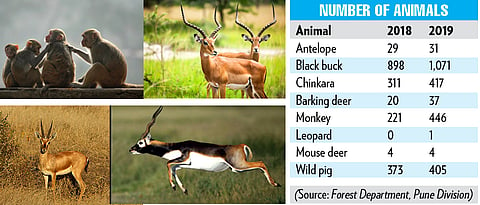

Pune: An increase in sightings of black bucks, chinkaras, antelopes and barking deers this year has been reported. As per the Census 2019 conducted by Forest Department’s Pune Division, one leopard was also sighted at Bhimashankar wildlife sanctuary.
A total of 125 forest staffers and 50 NGOs participated in the census conducted on May 18 and 19 at Bhimashankar Wildlife Sanctuary, Mayureshwar Wildlife Sanctuary, Rehekuri Sanctuary and Nanaj Sanctuary.
“We used motion sensor cameras which can click images of these animals without disturbing them. This increases the accuracy and there are chances as human eyes might miss some animals,” said Pune Division Conservator of Forests (Wildlife) RK Wankhede.
“This data is a population estimation and may not be the exact number. In fact, the scientific community does not recognise this data. but it is better to have estimated data rather than no data,” Wankhede added.
He said the data helps in understanding trends of animal population in the long run. “This gives us information about the animal population and we can take measures to conserve wildlife,” he said.
Better technology
Sachin Punekar, an environmentalist and Founder-President of Biospheres said, “This increase in data shows that the Forest Department is doing its work meticulously by protecting the habitat. This reflects that awareness has increased among people and more people are participating as there are more observers who are thoroughly collecting the data.”
“The Forest Department has adopted better technology by using cameras which helps in sighting maximum number of animals,” added Punekar.
Pune-based environmentalist Kiran Purandhare said, “This reflects the successful management by the Forest Department and increase in awareness among people regarding conservation of nature. However, the data fluctuates every year as there is local migration. The entire ethos of this exercise is to collect data and give an experience to people about the wildlife. This data is estimation as there are chances that 10 per cent of animals of the area are not counted. The mode of collection is old style, although it is first hand collection. But for the long run, it is important to adopt more scientific methodology. Once a year counting is also not sufficient, therefore counting should be more frequent.”
